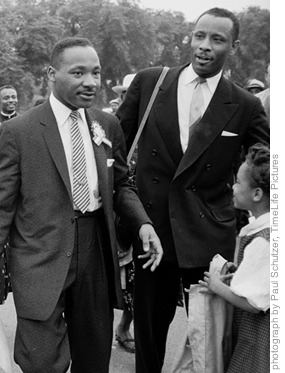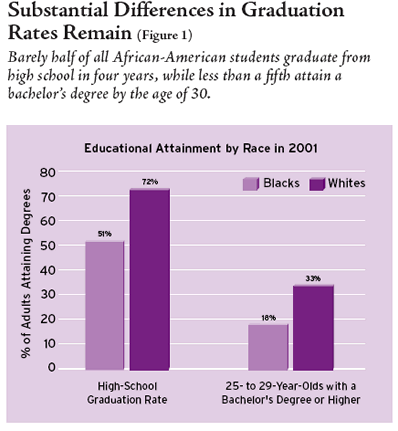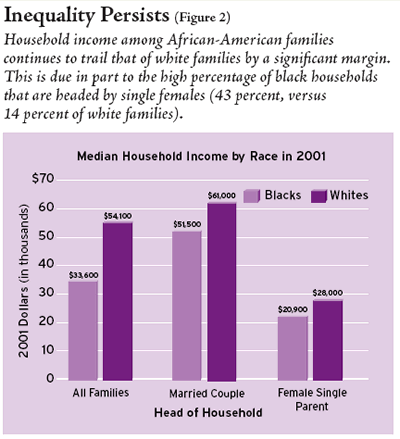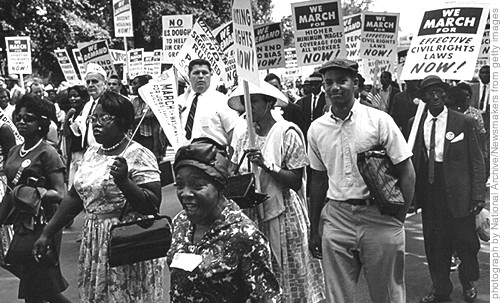 Relatively few people, black or white, who know anything about the reality of race relations in America during the 1950s would contest the revolutionary nature of the Supreme Court’s 1954 decision in Brown v. Board of Education. However, 50 years later, scholars are asking whether Brown has done more harm than good. The answer is no . . . but with qualifications.
Relatively few people, black or white, who know anything about the reality of race relations in America during the 1950s would contest the revolutionary nature of the Supreme Court’s 1954 decision in Brown v. Board of Education. However, 50 years later, scholars are asking whether Brown has done more harm than good. The answer is no . . . but with qualifications.
There is no denying Brown‘s contribution to ending the evil system of legal segregation and racial oppression in the United States. As Richard Kluger, author of Simple Justice, pointed out, “The Supreme Court had taken pains to limit the language of Brown to segregation in public schools only. . . . But it became almost immediately clear that Brown in effect wiped out all forms of state-sanctioned segregation.”
Until 1954 the “separate but equal” doctrine enshrined in the Plessy v. Ferguson decision defined the national norm. In the South, racial oppression was unrelenting, backed by the legal system and nurtured by the mores that could be traced back to our country’s slave era. In the North, de facto segregation and covert discrimination were commonplace. Everywhere, black people were expected to stay in “their place.”
These various forms of prejudice and discrimination had devastating consequences for black people. Consider that in 1954 the neonatal mortality rate per 1,000 live births was 17.8 for whites and 27.0 for “Negro and other.” Maternal mortality rates per 10,000 live births were 3.7 for whites, 14.4 for “Negro and other.” The average black household income in 1955 ($2,890) was 55 percent of that of white households ($5,228). In 1952, the illiteracy rate for blacks 14 years of age or older (10.2 percent) was more than five times that of whites (1.8 percent). More than a quarter of black males (28 percent) completed no more than four years of schooling, compared with less than 9 percent of white males (see Figures 1 & 2).
Beyond these statistics were the demeaning and oppressive rules and social customs that served as daily reminders of black people’s second-class status. There were the “rules of separation”—the colored and white bathrooms, water fountains, and waiting rooms; the fact that black people were forced to sit in the back of the bus and to step off the sidewalks when white people approached. There was the indignity of still being called “boy” at the age of 65.
 SOURCES: Jay Greene and Greg Forster, Public High School Graduation and College Readiness Rates in the U.S., Manhattan Institute for Policy Research; U.S. Department of Education
SOURCES: Jay Greene and Greg Forster, Public High School Graduation and College Readiness Rates in the U.S., Manhattan Institute for Policy Research; U.S. Department of Education
 SOURCE: U.S. Census Bureau
SOURCE: U.S. Census Bureau
Lifting the Veil of Oppression
For many people, Brown marked a critical turning point in addressing these inequities. Sara Lawrence Lightfoot remembers its impact vividly, writing:
Through a child’s eyes, I could see the veil of oppression lift from my parents’ shoulders. It seemed they were standing taller. And for the first time in my life, I saw tears in my father’s eyes. “This is a great and important day,” he said reverently to his children. And although we had not lived the pain and struggle of his life, nor did we understand the meaning of his words, the emotion and drama of that moment still survives in my soul today.
It seemed to her father and to many others that the United States was finally on the way to creating a society where discrimination based on race was unacceptable. The decision was certainly one of the sparks that stoked the flame of the civil-rights movement in the late 1950s and 1960s. It gave hope to tens of thousands of black people and their allies, who moved forward with courage and determination to transform American society.
In no small measure, these struggles changed America for black people. African-Americans today hold high-level positions in the government and private sector. Black hip-hop performers are a major force in defining the nation’s youth culture. The University of Kentucky now starts five black basketball players coached by a black man. These achievements were beyond the aspirations and certainly the reach of black people in 1954, irrespective of their academic records or life experiences.
Nonetheless, while it is clear that the Brown decision did more good than harm, it is equally clear that 50 years after the decision much of the promise of Brown still awaits fulfillment. The foundation for some of the questions and doubts about the decision’s legacy can be found in two separate but interrelated conceptual flaws inherent in Brown.
First, the Brown decision, while ending legally sanctioned segregation, did not (maybe could not) address the fundamental disparities in power inherent in a society where “white skin privilege” dominated. The decision did not prevent racists from using a variety of legal tactics and their control of law-enforcement agencies to resist the implementation of Brown. When desegregation did occur, it was almost always on terms favorable to whites. For instance, while black schools had to be closed (leading to demotions or the loss of jobs for black teachers and administrators), whites were given access to specialty schools or allowed to remain in their neighborhood schools. Likewise, new forms of “tracking” students were put into place to protect white children from “ill prepared” black children.
The second flaw arose from the view that equal education was not possible without integration. “The basic postulate of our strategy and theory in Brown,” said Robert Carter, the general counsel for the NAACP who played a major role in organizing the social-science testimony that was vital in the case, “was that the elimination of enforced segregated education would necessarily result in equal education.”
However, Carter and his colleagues did not consider the likelihood that black children would be placed in environments where the people who were being asked to teach them had no respect for them or their families. They did not realize all the ways educators could avoid teaching children whose education was of no interest to them. They did not grasp the capacity of those in charge to set up segregated classrooms and segregated activities within desegregated schools; to develop various ways of categorizing black students so that the best courses were reserved for white kids; and to concoct theories that essentially blamed the children and their families for the schools’ failure to teach them.
Moreover, the very idea that desegregating schools was the exclusive means of achieving equality assumed that black institutions and perhaps even black people were inferior. The language of Brown subtly reinforced this belief, stating, “Segregation of white and colored children in public schools has a detrimental effect on colored children.” The court cited Kenneth Clark’s famous doll experiment, which claimed to uncover self-hatred among black children and attributed it to the degrading effects of being taught in segregated schools. The court also quoted Gunnar Myrdal, who wrote in An American Dilemma, “[American Negro] culture is a distorted development, or a pathological condition, of the general American culture.”
Given these views, it followed that the only hope for black students to get a good education was to be rescued from their inferior institutions and pathologies and placed in integrated schools. And an integrated school was defined as one that was predominantly white. This ideology masked the inequities that existed in many so-called integrated schools.
 Unfinished Business
Unfinished Business
Recent statistics make it clear that black people are still struggling to enjoy the fruits of equal educational opportunity, despite the gains since Brown. On the 2003 National Assessment of Educational Progress, just 40 percent of black 4th graders scored at or above the “basic” level in reading, compared with 75 percent of white students. At the 8th-grade level, 54 percent of black students scored at or above basic, compared with 83 percent of white students. Just 51 percent of black students graduate from high school; the graduation rate among white students is 72 percent (see Figure 1).
Moreover, these educational inequalities help to explain enduring economic inequalities. For example, in 1998, 48 percent of black children age six and younger lived in families that were below 125 percent of the poverty line, compared with 24 percent of white children. The median household income for black families in 2001 was $33,600, while it was $54,100 for whites, a difference that can be attributed in part to the large number of black families headed by a single parent (see Figure 2). Although these conditions represent vast improvements from those of the 1950s, the differences in well-being between whites and blacks remain a stain on the nation.
So the struggle continues to make America a place where black people and black institutions are respected; where integration is viewed through the prism of pluralist acceptance; and where low-income and working-class black families have the power to secure the kind of education they desire for their children. The Brown decision sent a powerful message by tearing down the legal structures of oppression, but there remains plenty of unfinished business.
Howard L. Fuller is the director of the Institute for the Transformation of Learning at Marquette University and chairman of the board of directors of the Black Alliance for Educational Options.


